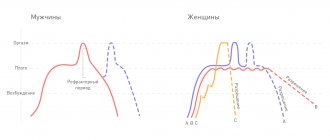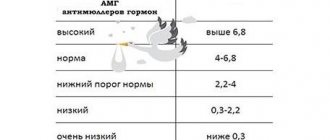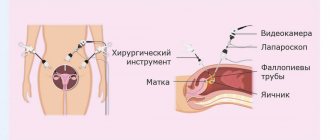If problems occur in the reproductive system (infertility), in addition to other tests, specialists at the K+31 reproductive medicine clinic prescribe an analysis to detect the level of FSH in the blood. Below is detailed information about what FSH hormone is and its importance to human health.
Follicle-stimulating hormone is produced by the anterior pituitary gland together with luteinizing hormone (LH). It plays an important role in regulating the functioning of the reproductive system. Its main task is to promote the formation and maturation of reproductive cells. The hormone also affects the synthesis of estrogen.
FGS affects the functioning of the male and female bodies differently.
FSH: what is it for women
In women, this hormone regulates the development and maturation of follicles in the ovaries. Within normal limits, FSH is elevated before ovulation. It is its high level that leads to its onset - the release of the egg from the follicle.
If FSH production is disrupted and its level deviates from the norm, this can lead to infertility and other serious problems.
Therefore, the answer to the question about FSH: “what is it for the body” can be the definition - it is one of the main regulators of the normal function of the female and male reproductive system.
How and when to get tested for hormones
“Donating hormones,” more precisely, taking blood for sex hormones and their regulators (FSH, prolactin, LH) requires compliance with simple conditions that will help achieve an accurate result without errors and errors.
So the FSH norm in women is usually determined on days 6-7 of the menstrual cycle. To prevent the FSH test result from being lowered or falsely elevated, you should:
• Three days before taking hormonal tests, avoid intense sports activities and training;
• You should not smoke 1 hour before donating blood;
• 10-15 minutes before taking blood, you should rest and calm down, then the result will be without errors.
If these simple conditions are not followed, the result may be that the FSH level is increased or decreased. Moreover, both low FSH and a high level of this indicator in such conditions may turn out to be erroneous.
The FSH norm in women and men in the blood is determined in the morning and on an empty stomach (from approximately 8 to 11 o’clock).
Since FSH can be decreased or increased due to its pulsed entry into the bloodstream, it is recommended to take 3 blood samples at once, each with an interval of 30 minutes or more.
Low LH levels
The main causes of low levels of luteinizing hormone include the following:
- taking medications,
- lack of menstruation,
- amenorrhea,
- pregnancy,
- with impaired activity of the pituitary gland,
- with an increase in prolactin in the blood,
- obesity,
- luteal phase deficiency.
Decreased and elevated levels of the hormone in the body are a symptom of other diseases or conditions (for example, fasting or pregnancy). To normalize the hormone, the underlying disease should be determined and appropriate therapy prescribed.
If there is a decrease or increase in any hormones in the blood, you should not self-medicate. It is worth consulting a doctor to get the necessary treatment.
If you want to have a baby, but you are unable to get pregnant, then the IVF Center clinic in Arkhangelsk is waiting for you. Our specialists will be able to advise you and conduct a comprehensive examination. Once diagnosed, you will undergo a course of conservative treatment. If necessary, our doctors will carry out the IVF procedure. We will help you experience all the joy of motherhood.
Tests for follicle-stimulating hormone: normal
Normally, FSH is highest in men in the summer.
Another important indicator is how the LH and FSH norms correlate in women. So, before the start of the first menstruation, the LH/FSH norm is 1. A year after the onset of menstruation, the LH/FSH norm is 1-1.5. Two years after the start of menstruation and until menopause, LH/FSH in women is 1.5-2. If LH or FSH is increased or decreased, this ratio changes markedly.
The FSH norm in women during the reproductive period averages 0.57 - 8.77 mU/ml.
In girls under 14 years of age, the norm can range from 0.19 to 7.9 mIU/ml.
The FSH norm in women varies during different periods from the beginning of the first menstruation, depending on the phase of the cycle. FSH is lowered more in the luteal phase of the cycle and is in the range of 1.09 – 9.2 mU/ml. FSH is increased more in the ovulatory phase and amounts to 6.17 -17.2. Compared to these figures, in the follicular phase FSH is reduced to 1.37-9.9 mU/ml.
The level of this hormone in postmenopausal women is 19.3 - 100.6 mU/ml, that is, during this period this indicator is significantly increased.
Compared to the indicators in women, in men over 21 years of age FSH is 0.95 – 11.95. In other age periods in men, FSH is reduced and can be less than 9.9 mIU/ml.
Follicle-stimulating hormone (FSH) is a glycoprotein hormone that is produced and accumulated in the anterior pituitary gland and affects the functioning of the gonads.
Synonyms Russian
FSH, follitropin, pituitary gonadotropin.
English synonyms
Follicle-Stimulating Hormone, Follitropin, FSH, Pituitary Gonadotropin.
Research method
Chemiluminescent immunoassay.
Units
mIU/ml (international milliunit per milliliter).
Determination range: 0.1 - 200 mIU/ml.
What biomaterial can be used for research?
Venous blood.
How to properly prepare for research?
- Do not eat for 2-3 hours before the test (you can drink clean still water).
- 48 hours before the study (in consultation with the doctor), stop taking steroid and thyroid hormones.
- Avoid physical and emotional stress 24 hours before the test.
- Do not smoke for 3 hours before the test.
General information about the study
Follicle-stimulating hormone (FSH) together with luteinizing hormone (LH) is produced in the anterior pituitary gland under the influence of hypothalamic gonadotropin-liberating hormone. FSH secretion occurs in pulse mode at intervals of 1-4 hours. During a surge lasting about 15 minutes, the concentration of FSH exceeds the average by 1.5-2.5 times and is regulated by the level of sex hormones according to the principle of negative feedback. Low levels of sex hormones stimulate the release of FSH into the blood, and high levels inhibit it. The production of FSH is also suppressed by the protein inhibin B, which is synthesized in ovarian cells in women and in the cells lining the seminiferous tubules (Sertoli cells) in men.
In children, FSH levels increase briefly after birth and fall very sharply at 6 months in boys and at 1-2 years in girls. Then it increases before the onset of puberty and the appearance of secondary sexual characteristics. One of the first laboratory indicators of the onset of puberty (puberty) in children is an increase in FSH concentration at night. At the same time, the response of the gonads increases and the level of sex hormones increases.
In women, FSH stimulates the maturation of ovarian follicles, prepares them for the effects of luteinizing hormone and enhances the release of estrogens. The menstrual cycle consists of follicular and luteal phases. The first phase of the cycle takes place under the influence of FSH: the follicle enlarges and produces estradiol, and at the end, a sharp increase in the levels of follicle-stimulating and luteinizing hormones provokes ovulation - the rupture of a mature follicle and the release of an egg. Then comes the luteal phase, during which FSH promotes the production of progesterone. Estradiol and progesterone regulate the synthesis of FSH by the pituitary gland via a feedback principle. During menopause, the ovaries stop functioning and decreased secretion of estradiol leads to increased concentrations of follicle-stimulating and luteinizing hormones.
In men, FSH affects the development of seminiferous tubules, increases testosterone concentrations, stimulates the formation and maturation of sperm in the testicles and promotes the production of androgen binding protein. After puberty, FSH levels in men are relatively constant. Primary testicular failure leads to an increase in its number.
Analysis for gonadotropic hormones allows you to determine the level of hormonal regulation disorders - primary (depending on the gonads themselves) or secondary (associated with the hypothalamic-pituitary axis). In patients with testicular (or ovarian) dysfunction, low FSH levels indicate dysfunction of the hypothalamus or pituitary gland. An increase in FSH indicates a primary pathology of the gonads.
Simultaneous tests for follicle-stimulating and luteinizing hormones are used to diagnose male and female infertility and determine treatment tactics.
What is the research used for?
- To identify the causes of infertility (together with a test for other sex hormones: luteinizing hormone, testosterone, estradiol, progesterone).
- To determine the phase of the menstrual cycle (menopause).
- To diagnose the causes of spermatogenesis disorders and reduced sperm count.
- To identify primary or secondary causes of sexual dysfunction (pathology of the gonads or hypothalamic-pituitary disorders).
- For the diagnosis of early or late puberty.
- To monitor the effectiveness of hormone therapy.
When is the study scheduled?
- For infertility.
- If pathology of the pituitary gland and sexual dysfunction are suspected.
- In case of menstrual irregularities (its absence or irregularity).
- When the patient has congenital diseases with chromosomal abnormalities.
- For growth and maturation disorders in children.
- When using hormonal drugs.
What do the results mean?
Reference values
| Floor | Cycle phase | Reference values |
| Male | 1.5 - 12.4 mIU/ml | |
| Female | Menstrual (1-6th day) | 3.5 - 12.5 mIU/ml |
| Folliculin (proliferative) (3-14th day) | 3.5 - 12.5 mIU/ml | |
| Ovulatory (day 13-15) | 4.7 - 21.5 mIU/ml | |
| Luteal (15th day - beginning of menstruation) | 1.7 - 7.7 mIU/ml | |
| Postmenopause | 25.8 - 134.8 mIU/ml | |
| Premenopause | 1.7 - 21.5 mIU/ml |
Menopause. Reasons for increased FSH levels
- Primary ovarian failure (premature ovarian failure syndrome, ovarian dyskinesia syndrome, ovarian tumors and cysts, Shereshevsky-Turner syndrome, Swire syndrome, insufficient production of steroid hormones by the ovaries - 17-alpha-hydroxylase deficiency).
- Primary testicular failure in men (testicular aplasia or agenesis, Klinefelter syndrome, testicular tumors).
- Hypogonadism due to exposure of the ovaries or testicles to any external factors (x-rays, chemotherapy, alcohol, infectious diseases, autoimmune diseases, trauma, castration).
- Hyperfunction or tumors of the pituitary gland.
- Endometriosis.
- Testicular feminization.
- Ectopic secretion in some hormone-secreting neoplasms (usually in lung tumors).
- Premature puberty.
- Alcoholism.
Reasons for decreased FSH levels in the blood
- Deficiency of hypothalamic gonadoliberin (Kallmann syndrome - congenital secondary hypogonadism - a disorder of impulse secretion of gonadoliberin in the hypothalamus).
- Isolated FSH deficiency.
- Pituitary insufficiency.
- Dwarfism.
- Sheehan's syndrome.
- Hyperprolactinemia.
- Neoplasms of the ovaries, testes and adrenal glands with increased secretion of estrogens and androgens.
- Polycystic ovary syndrome.
- Hemochromatosis.
- Anorexia and starvation.
What can influence the result?
- Inadequate FSH levels are possible due to the patient taking radioisotope drugs, oral hormonal drugs, pregnancy, introduction of heterophile antibodies (including monoclonal) into the body, nuclear magnetic resonance scanning of the patient performed shortly before the FSH test, smoking and alcohol consumption.
- Medicines and substances that increase the level of FSH in the blood: bicalutamide, bromocriptine, cimetidine, clomiphene, danazol, digitalis, erythropoietin, finasteride, GnRH analogs, somatoliberin, hydrocortisone, ketoconazole, leuprolide, levodopa, metformin, naloxone, nilutamide, phenytoin, pravastatin, tamoxifen.
- Medicines and substances that reduce the level of FSH in the blood: anabolic steroids, anticonvulsants, carbamazepine, conjugated estrogens, corticoliberin, danazol, diethylstilbestrol, estrogen- and progesterone-containing drugs, finasteril, goserelin, medroxyprogesterone, megestrol, octreotide, oral contraceptives, phenothiazides, pimozide, prednisolone, stanozolol, toremifene, valproic acid.










